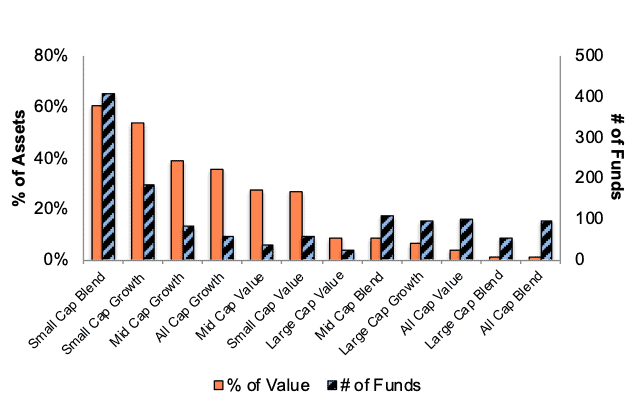At the beginning of 3Q24, the All Cap Value, Large Cap Value, and All Cap Blend styles earn Attractive-or-better rating. Our style ratings are based on a normalized aggregation of our fund ratings for every ETF and mutual fund in a given style. Our fund ratings are based on aggregations of the ratings of the stocks they hold.
Investors looking for style funds that hold quality stocks should focus on the All Cap Value, Large Cap Value, and All Cap Blend styles. Figures 4 through 7 provide more details on the ratings of overall styles, underlying assets, and individual funds. The primary driver behind an Attractive fund rating is good portfolio management, or good stock-picking, with low total annual costs.
Attractive-or-better ratings do not always correlate with Attractive-or-better total annual costs. This fact underscores that (1) cheap funds can dupe investors and (2) investors should invest only in funds with good stocks and low fees.
See Figures 4 through 13 for a detailed breakdown of ratings distributions by investment style.
Figure 1: Ratings for All Investment Styles
New Constructs, LLC
Source: New Constructs, LLC and company filings
To earn an Attractive-or-better Predictive Rating, an ETF or mutual fund must have high-quality holdings and low costs. Only the top 30% of all ETFs and mutual funds earn our Attractive-or-better rating.
Euclidean Fundamental Value ETF (ECML) is the top-rated All Cap Value fund. It gets our Very Attractive rating by allocating over 75% of its value to Attractive-or-better-rated stocks.
Voya Small Cap Growth Fund (VWYFX) is one of the worst rated Small Cap Growth funds. It gets our Very Unattractive rating by allocating over 64% of its value to Unattractive-or-worse-rated stocks. Making matters worse, it charges investors total annual costs of 4.07%.
Figure 2 shows the distribution of our Predictive Ratings for all investment style ETFs and mutual funds.
Figure 2: Distribution of ETFs & Mutual Funds (Assets and Count) by Predictive Rating
New Constructs, LLC
Source: New Constructs, LLC and company filings
Figure 3 offers additional details on the quality of the investment style funds. Note that the average total annual cost of Very Unattractive funds is more than seven times that of Very Attractive funds.
Figure 3: Predictive Rating Distribution Stats
New Constructs, LLC
* Avg TAC = Weighted Average Total Annual Costs
Source: New Constructs, LLC and company filings
This table shows that only the best of the best funds get our Very Attractive Rating: they must hold good stocks AND have low costs.
Ratings by Investment Style
Figure 4 presents a mapping of Very Attractive funds by investment style. The chart shows the number of Very Attractive funds in each style and the percentage of assets allocated to Very Attractive-rated funds.
Figure 4: Very Attractive ETFs & Mutual Funds by Investment Style
New Constructs, LLC
Source: New Constructs, LLC and company filings
Figure 5 presents the data charted in Figure 4.
Figure 5: Very Attractive ETFs & Mutual Funds by Investment Style
New Constructs, LLC
Source: New Constructs, LLC and company filings
Figure 6 presents a mapping of Attractive funds by investment style. The chart shows the number of Attractive funds in each style and the percentage of assets allocated to Attractive-rated funds.
Figure 6: Attractive ETFs & Mutual Funds by Investment Style
New Constructs, LLC
Source: New Constructs, LLC and company filings
Figure 7 presents the data charted in Figure 6.
Figure 7: Attractive ETFs & Mutual Funds by Investment Style
New Constructs, LLC
Source: New Constructs, LLC and company filings
Figure 8 presents a mapping of Neutral funds by investment style. The chart shows the number of Neutral funds in each style and the percentage of assets allocated to Neutral-rated funds.
Figure 8: Neutral ETFs & Mutual Funds by Investment Style
New Constructs, LLC
Source: New Constructs, LLC and company filings
Figure 9 presents the data charted in Figure 8.
Figure 9: Neutral ETFs & Mutual Funds by Investment Style
New Constructs, LLC
Source: New Constructs, LLC and company filings
Figure 10 presents a mapping of Unattractive funds by investment style. The chart shows the number of Unattractive funds in each style and the percentage of assets allocated to Unattractive-rated funds.
The landscape of style ETFs and mutual funds is littered with Unattractive funds. Investors in Small Cap Blend have put over 60% of their assets in Unattractive-rated funds.
Figure 10: Unattractive ETFs & Mutual Funds by Investment Style
New Constructs, LLC
Source: New Constructs, LLC and company filings
Figure 11 presents the data charted in Figure 10.
Figure 11: Unattractive ETFs & Mutual Funds by Investment Style
New Constructs, LLC
Source: New Constructs, LLC and company filings
Figure 12 presents a mapping of Very Unattractive funds by investment style. The chart shows the number of Very Unattractive funds in each style and the percentage of assets allocated to Very Unattractive-rated funds.
Figure 12: Very Unattractive ETFs & Mutual Funds by Investment Style
New Constructs, LLC
Source: New Constructs, LLC and company filings
Figure 13 presents the data charted in Figure 12.
Figure 13: Very Unattractive ETFs & Mutual Funds by Investment Style
New Constructs, LLC
Source: New Constructs, LLC and company filings
This article originally published on July 16, 2024.
Read the full article here



